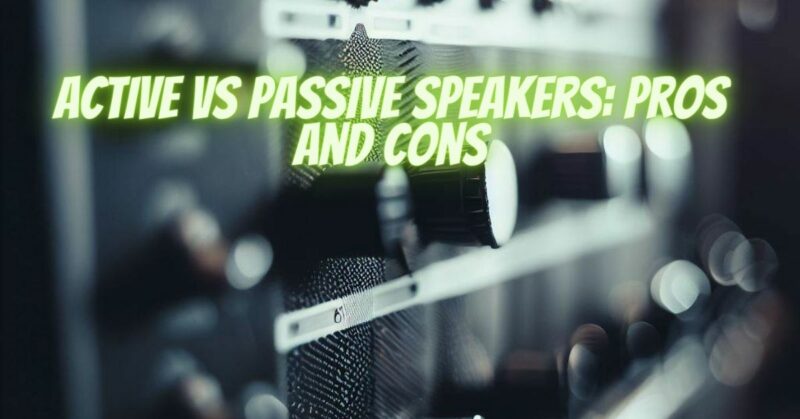When it comes to choosing speakers for your audio system, two main types are commonly available: active (powered) speakers and passive speakers. Both have their strengths and weaknesses, and understanding the pros and cons of each can help you make an informed decision that aligns with your specific needs and preferences. In this article, we will explore the advantages and disadvantages of active and passive speakers to help you choose the right option for your audio setup.
Active Speakers:
Pros:
- Built-in Amplification: Active speakers have a built-in amplifier, eliminating the need for an external amplifier. This convenience streamlines your setup and reduces the number of components required.
- Precise Amplifier Matching: The amplifier inside active speakers is precisely tuned and matched to the speaker drivers, ensuring optimal performance and sound quality.
- Simplicity: Active speakers are often plug-and-play, making them user-friendly and straightforward to set up. They are an ideal choice for users who prefer a hassle-free audio solution.
- Space-Saving: With the amplifier integrated into the speaker cabinet, active speakers generally require less space compared to a separate amplifier setup for passive speakers.
Cons:
- Limited Upgradability: Since the amplifier is integrated into the speakers, upgrading the amplifier would require replacing the entire speaker unit.
- Cost: Active speakers tend to be more expensive compared to passive speakers with similar sound quality, mainly due to the built-in amplification.
- Weight: Active speakers are generally heavier due to the inclusion of the amplifier, which might affect portability for some users.
Passive Speakers:
Pros:
- Customization: Passive speakers offer greater flexibility in amplifier selection, allowing you to tailor your sound experience to your preferences.
- Upgradability: With separate components (speakers and amplifiers), passive speaker setups allow for easy upgrades by replacing individual parts over time.
- Sound Quality Potential: In high-fidelity setups, top-quality passive speakers paired with premium amplifiers can achieve audiophile-grade sound quality.
- Versatility: Passive speakers can be used in various audio setups and applications, providing more adaptability for different listening environments.
Cons:
- External Amplifier: Passive speakers require an external amplifier, which adds complexity to the setup and might be less convenient for some users.
- Impedance Matching: Careful consideration of impedance matching between speakers and amplifier is necessary to avoid potential issues with performance and safety.
- Larger Footprint: Separating the amplifier from the speaker adds to the overall footprint of the audio system, which might be less suitable for compact spaces.
The choice between active and passive speakers depends on your specific requirements and preferences. Active speakers are an excellent option for users seeking simplicity, convenience, and precise amplifier matching, making them ideal for those who want an all-in-one audio solution. On the other hand, passive speakers offer more customization options, potential for high-end sound quality, and upgradability, making them a preferred choice for audiophiles and users who prioritize sound control and system flexibility.
When making your decision, consider factors such as sound quality, upgradability, budget, available space, and personal preferences. Both active and passive speakers can provide exceptional sound experiences, and the key is to choose the option that best suits your audio needs and enhances your enjoyment of music, movies, and entertainment.


